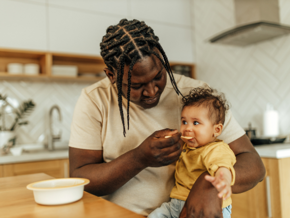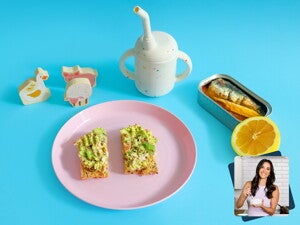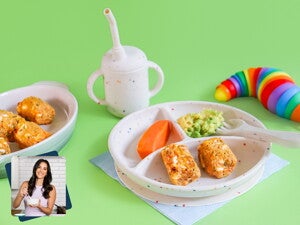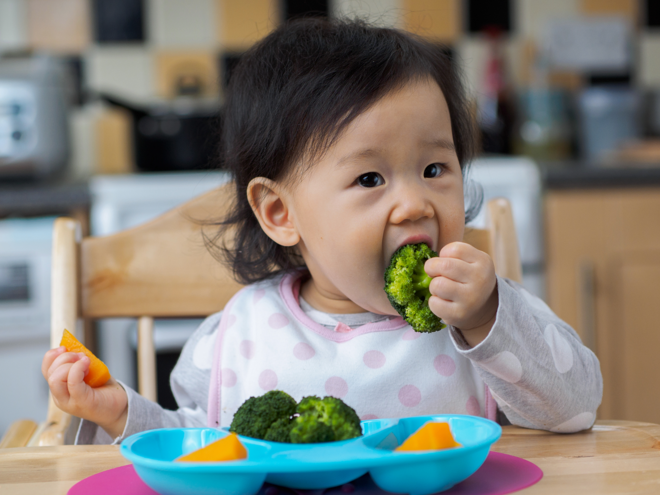
Baby-led weaning (BLW) is an alternative approach to the traditional method of starting solids which introduces foods by spoon-feeding thin purees and then stepping up through thicker, mashed and soft foods and eventually to family foods. Instead, from around six months, babies are offered safe, appropriately prepared pieces of whole food they can grasp and feed themselves. Many parents however use a combination of finger foods and puree foods.
BLW aims to give babies the freedom to explore food at their own pace while still supporting aspects of their development. Starting solid food encourages the growth of oral motor skills, including, chewing, tongue lateralisation (moving food side to side in the mouth), and controlled biting, that form the foundation for safe swallowing and later speech development. Experiencing a variety of food shapes and textures can improve oral mapping, the process by which babies learn to sense where food is in their mouth and coordinate movements to chew and swallow effectively.
BLW can support responsive feeding, where babies decide what and how much to eat, helping them develop self-regulation and a positive relationship with food. By offering the same (appropriately modified) meals as the rest of the family, babies are included in shared mealtimes, which supports their social and emotional development.
Compared to traditional weaning BLW gives more exposure to finger foods from the start. Both methods of introducing solids can provide balanced nutrition when done well. For a deeper dive into the philosophy and evidence behind this BLW approach, see What is BLW? Your Guide to Baby-Led Weaning.
What age should I start baby-led weaning?
Most Australian health authorities, including the National Health and Medical Research Council (NHMRC) and Raising Children Network, recommend starting solids at around six months (never prior to four months). This timing ensures that babies are developmentally ready.
Developmental readiness is essential for BLW. Look for signs such as:
- Sitting upright without support for short periods
- Good head and neck control
- Ability to grasp food and bring it to the mouth
- Interest in food, such as watching others eat or reaching for food
Waiting until these readiness cues are apparent can help reduce choking risk and ensure babies can safely handle finger foods. If your baby is not showing these signs of readiness they may not be ready for BLW. All babies should be starting on solid food by 6 months of age. If BLW is not suitable for your baby by this age it doesn’t mean you should delay introducing solid foods. Instead try more appropriate textures such as pureed foods and slowly progress to finger foods as it suits your child. Babies who start BLW before these skills are in place may struggle to move food around their mouth or coordinate swallowing. If you have any concerns about your baby’s readiness to start solids or start BLW, talk to your healthcare professional.
Choosing the best baby-led weaning foods
When choosing first finger foods, prioritise options that are nutrient-rich, soft enough to mash with gums, and in shapes and sizes that are easy for small hands to hold. Iron-rich foods are especially important at this age, as babies’ iron stores from birth start to deplete around six months. Ideal baby led weaning foods that are soft, nutrient-rich, and easy for babies to hold can include:
Baby finger foods that are iron-rich
Iron is essential for healthy brain development, energy production, and immune function. Including iron-rich foods from the start helps meet babies’ high iron needs at this age.
- Strips of slow-cooked beef or lamb (soft enough to shred with gums)
- Flaked salmon, sardines, or other oily fish
- Omelette strips
- Tofu cut into finger sized sticks
- Chickpea hummus spread thickly on toast
- Iron-fortified infant cereals shaped into small, soft patties for self-feeding. Additionally, iron-fortified cereal can be sprinkled onto any finger foods, or eaten as a puree separate to their finger foods.

(pictured: beef and lentil meatball, chicken drumsticks, salmon fillet, omelette, tofu)
Baby finger foods - Vegetables
- Steamed carrot sticks
- Soft-cooked broccoli florets
- Steamed sweet potato wedges
- Steamed zucchini batons
- Steamed corn on the cob (hard and resistive food - see tip below)
Vegetables offer essential vitamins, minerals, and fibre. Cooking them until soft allows babies to practise chewing while still being able to squash the food easily between their gums.
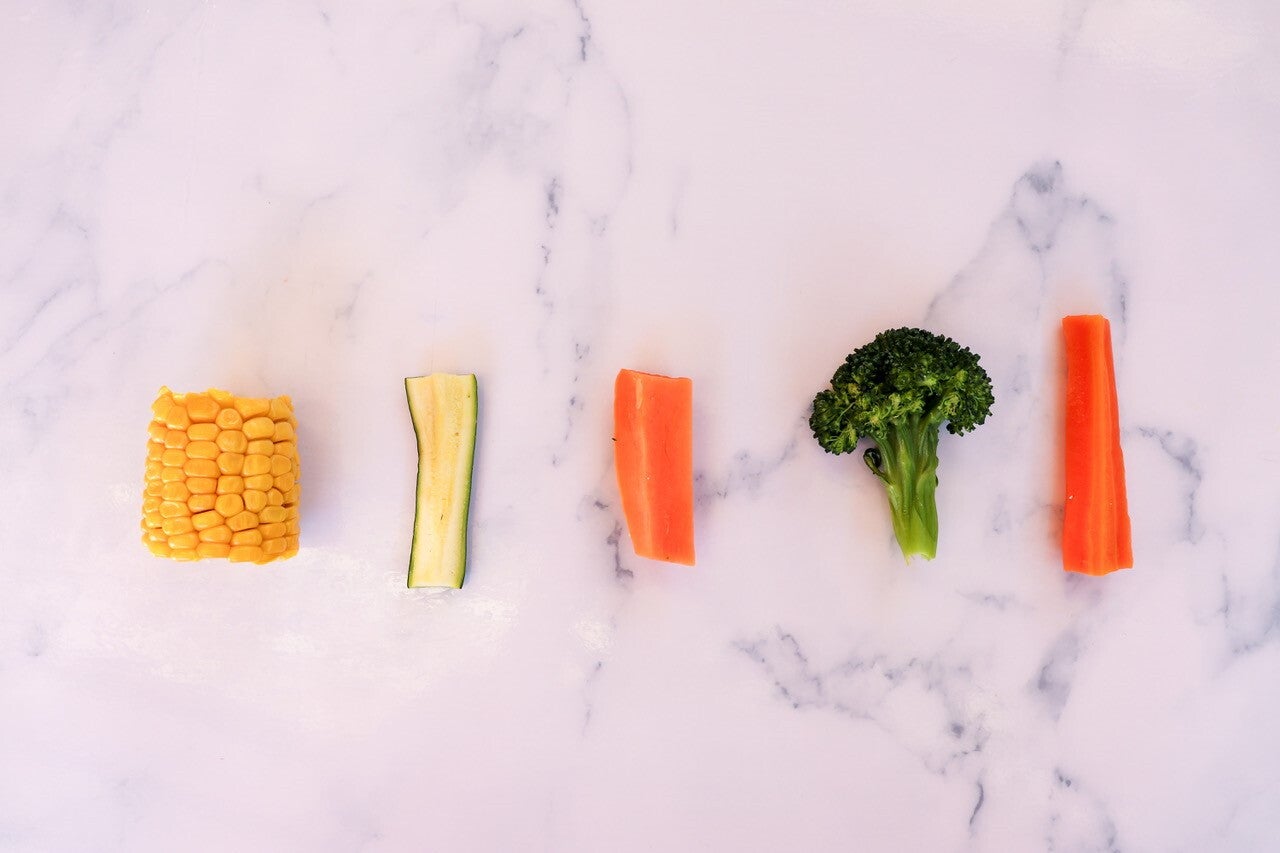
(pictured: corn on the cob, zucchini, sweet potato, broccoli, carrot)
Baby finger foods - Fruits
- Avocado slices
- Banana halves
- Large ripe strawberry
- Peeled and steamed pear wedges
- Mango seed (hard and resistive food – see tip below)
Ripe fruits are naturally soft and hydrating, and their sweet flavours make them a great introduction to self-feeding. Choose finger-length shapes to help babies grip food with their whole hand. Keeping in mind with baby led weaning foods the bigger the piece the lower the choking risk.
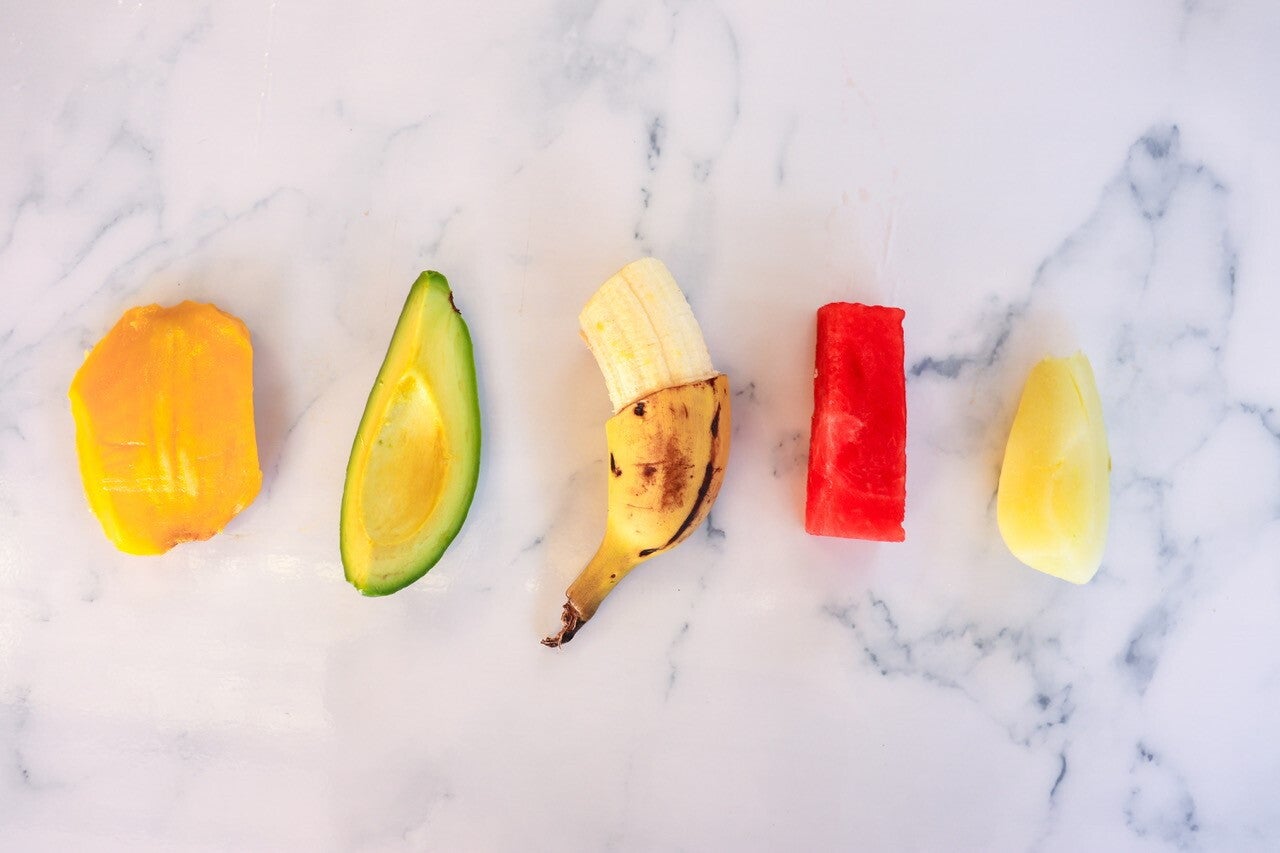
(pictured: mango seed, avocado, banana, watermelon, cooked and peeled pear)
TIP: While most baby-led weaning foods should be soft enough for babies to mash with their gums, offering occasional hard or resistive foods that are unbreakable such as the core of a ripe mango seed, a lamb chop or a cooked corn on the cob, can be beneficial. These items encourage chewing practice, jaw strengthening, and oral exploration, supporting the development of oral motor skills. They should always be large enough to prevent choking and offered under close supervision.
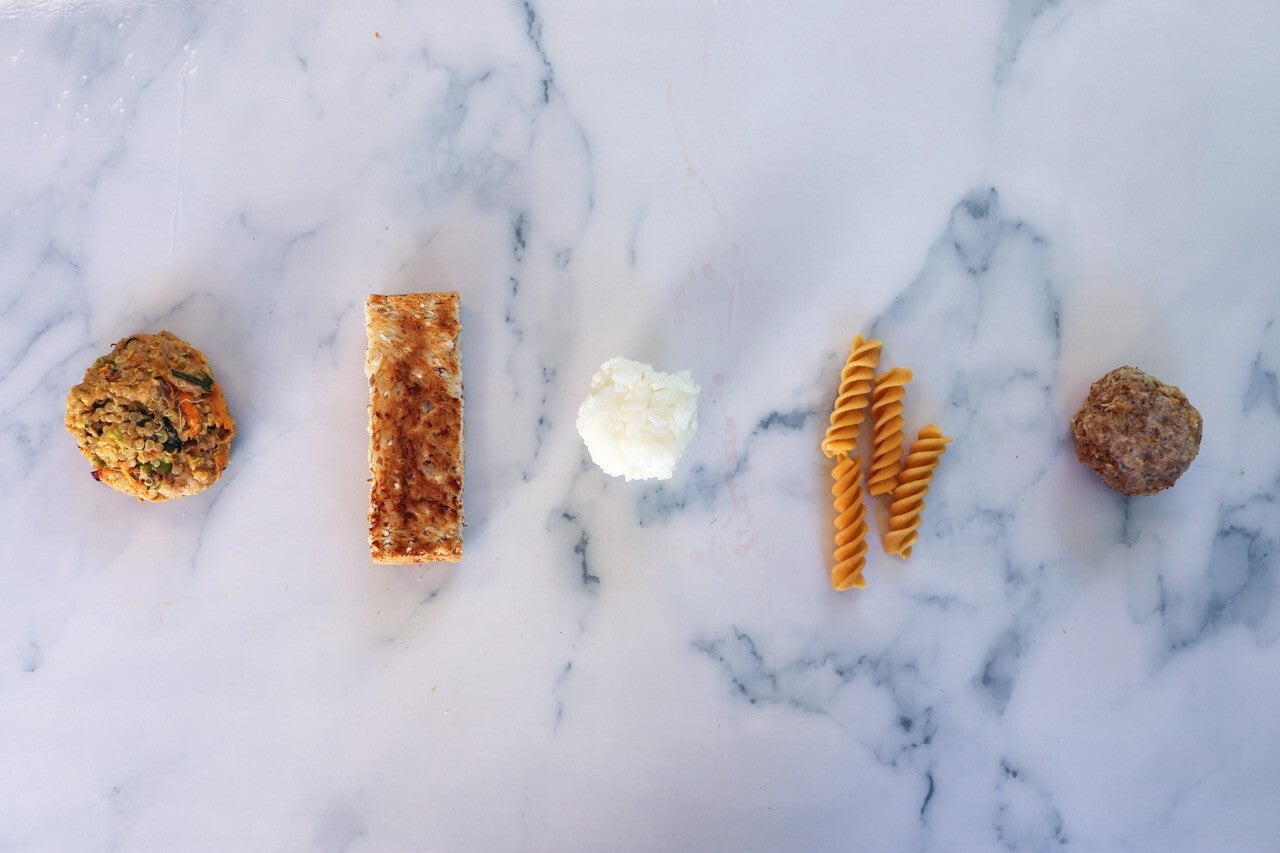
(pictured: quinoa patties, wholegrain toast, rice ball, cooked pasta, turkey meatball)
Best baby led weaning foods by age
While every baby develops at their own pace, the following guide lists some key blw foods by age.
BLW foods for 6 month-old to 8 months
- At this age larger shapes are safer. Baby weaning food should be large enough for baby to hold in their fist with some of the food sticking out, think adult finger length and approximately the width of two adult fingers.
- Food should be soft enough to mash between two fingers, or be a hard and resistive unbreakable food to act as a teether.
- Large soft pieces of food such as cooked and peeled pear, steamed apple or roasted zucchini and sweet potato, or soft omelette strips.
- Iron-rich options like strips of salmon, slow-cooked meat strips, or soft beef rissoles.
BLW foods for 9 month-old to 11 months
- At this age babies begin to develop their pincer grip, which is picking up things between their thumb and first finger. This means smaller foods can be introduced to help practice this new skill.
- New textures during this age might include grated foods like grated firm tofu, cheese, or carrots. Bite sized pieces of soft foods like steamed or roasted vegetables, omelettes, quartered cherry tomatoes, sliced strawberries.
- Continue to include iron rich foods progressing texture to include foods like shredded chicken, diced silken tofu, boiled egg cut into bite sized pieces, flattened legumes, and beef rissole broken into smaller pieces.
BLW foods for 12 month-old to 18 months
- By 12 months babies who have had ongoing exposure to and practice with a variety of foods and textures will be able to progress to mostly family foods with some minor modifications.
- Firmer textures and more complex combinations: mini sandwiches, a variety of pasta shapes, homemade muffins, cooked grains, whole canned or cooked legumes.
- By this stage, babies are refining chewing, biting and tearing, and pincer grip skills
- Mealtimes can increasingly resemble the family’s plate, with modifications for salt and sugar
- Continue to avoid foods that are an increased choking risk such as sticky foods (thick nut butter, marshmallows), round foods (hot dogs, cherry tomatoes, grapes), whole raw foods unless grated (carrots, apple) and hard to chew foods (popcorn and whole nuts).
Once your baby is confident with self-feeding, explore some BLW recipes.
How to cut and prep whole foods for baby-led weaning
Safe preparation is a cornerstone of BLW. The goal is to offer food in a size and shape that babies can hold securely but won’t easily lodge in their airway.
Tips for safe prep:
- Cut foods into finger-sized strips or wedges for younger babies (whole-hand grasp)
- Quarter round foods like grapes or cherry tomatoes lengthwise
- Remove tough or slippery skins when needed
- Steam, roast, or lightly sauté foods to soften them while preserving nutrients
- Avoid overcooking, which can make foods too mushy to grasp
- Advance to smaller pieces of food as baby is able to use a pincer grip to pick up foods.
For more details, see these Food Safety Rules for Families.
Foods to avoid while doing BLW
Certain foods pose either a choking risk or a nutritional concern for babies.
Avoid:
- Whole grapes (instead cut these into quarters)
- Whole nuts (instead use smooth nut butters)
- Popcorn
- Hard foods like raw carrot and apple
- Large chunks of tough meat (instead cut into strips they can hold)
- Honey (until after 12 months, due to botulism risk)
- Foods high in salt (e.g. deli meats, salty snacks)
- Foods high in added sugar (sweet biscuits, confectionery)
Babies’ kidneys can’t handle high sodium (salt) levels, and excess sugar offers little nutritional value while shaping long-term taste preferences. Wherever possible, choose a variety of nutritious age-appropriate foods that nourish and support your little one’s healthy development.
Safety tips for starting baby-led weaning
Appropriate safety measures should always be followed when feeding your little one. Key points to consider to reduce the risk of choking can include:
- Gagging is normal and part of learning; choking is an emergency.
- Always supervise meals and feed in an age-appropriate chair.
- To begin offer foods that are soft enough to squash between fingers or hard resistive foods to help develop oral mapping and chewing practice.
- Avoid foods that are hard, round, or sticky.
- Learn infant first aid and choking response skills.
Supporting your baby’s BLW journey
BLW isn’t just about feeding it’s about helping your baby build independence, confidence, and positive eating habits.
The benefits can include:
- Improved fine motor skills and hand–eye coordination
- Early development of chewing and oral motor skills
- Increased exposure to flavours and textures
- Encouragement of appetite self-regulation
Every baby will progress differently. The aim is to create a safe, positive, and pressure-free environment where your baby can explore food in their own way.

(pictured: toast with avocado and hemp seeds, well-cooked carrot, lentil and beef ball)
Frequently asked questions about baby led weaning
What foods to start with baby-led weaning?
Begin with soft, easy-to-grip foods such as steamed vegetables, ripe fruits, scrambled egg strips, mashed legumes, and tender fish or meat. Include iron-rich options early.
What to avoid in BLW?
Avoid shapes, sizes and textures of foods that are choking hazards, honey under 12 months, cow’s milk as a main drink under 12 months, high-salt foods, and foods with added sugar.
When to stop purees for baby led weaning?
If doing BLW exclusively, purées aren’t started at all. If using a mixed approach, you can transition away from purées around six months as your baby shows readiness for finger foods.
>Can I mix purees and baby-led weaning?
Yes. Many families combine the two approaches to suit their baby’s needs, offering purées alongside finger foods to encourage both self-feeding and variety.
Sources:
- National Health and Medical Research Council. Infant Feeding Guidelines. Canberra: NHMRC; 2012.
- World Health Organization. Guiding Principles for Complementary Feeding of the Breastfed Child. Geneva: WHO; 2003.
- Raising Children Network. Introducing solids: Baby-led weaning. Available at: https://raisingchildren.net.au
- Cameron SL, Heath A-LM, Taylor RW. Healthcare professionals’ and mothers’ knowledge of, attitudes to and experiences with Baby-Led Weaning: A content analysis study. BMJ Open. 2012;2:e001542.
- Rapley G, Murkett T. Baby-led Weaning: Helping your baby to love good food. London: Vermilion; 2010.
- Australian Society of Clinical Immunology and Allergy (ASCIA). Feeding your baby and toddler. Available at: https://www.allergy.org.au


